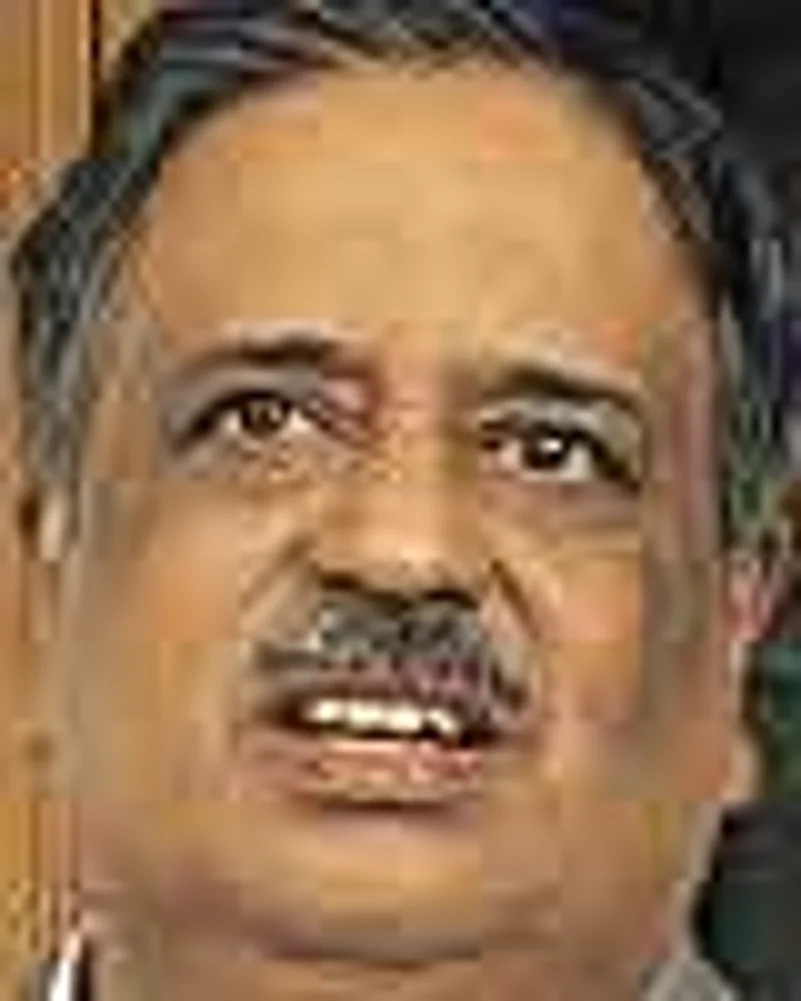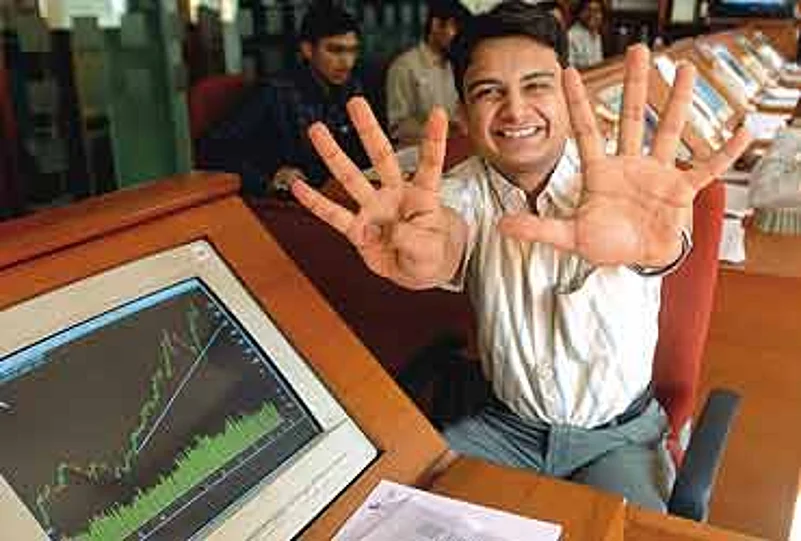***

Manmohan Singh Prime Minister
In the pre-Harshad Mehta scam days, the then FM said he does not lose any sleep over what happens in the market. But in September this year, he reacted violently to reports that thePMO was worried about the markets, apparently to boost investor confidence. The day the Sensex shed over 250 points, thePMO clarified it hadn’t held any meeting with regulators to
monitor the market.

P. Chidambaram Union Finance Minister
He resigned as the commerce minister in 1992 because of the Harshad Mehta scam. Now, he oscillates between warning the small investors and pepping up the big ones. At 7200 Sensex, he said he would be worried if it reaches 8000. At 7400, he asked the retail investors to be very cautious and said "unnecessary exuberance can lead toirrational despondency". When it crossed 8500, he lashed out against bearish sentiments as he felt the Indian corporates were performing well. At 9000, he felt it was still a good time to buy. What’ll it be at 10,000?

M. Damodaran Chairman, SEBI
In June, he found nothing very disturbing about the market. In August, a SEBI director speculated that the Sensex may touch 16000 before April 2006. A month later, theSEBI chief said he was aware of the scorching pace of the markets. Then came the over-250 points crash in the Sensex on September 22 and every regulator worked hard to calm the investors' nerves.

Y.V. Reddy Governor, RBI
Before the September 22 fall, he said the RBI was keeping a close watch on the market exposures of urban cooperative banks and even theNBFCs. Later, he just kept mum.

Rakesh Jhunjhunwala High-Networth Investor
At several fora, he has predicted the Sensex to cross 25000 over the next few years. Like a true-blue bull, he isgung-ho about corporate performances and India's future financial and economic growth.
***
India has been truly Sensexed. After the Bombay Stock Exchange index, the Sensex, crossed the 9000 mark, investment advisors started speculating if it will cross 10000 this year itself. In other pockets too—in the North Block offices of the finance ministry, corporate boardrooms, media headquarters, party circles, and middle-class homes—the talk is about the Sensex and the Nifty (the National Stock Exchange index). The creamy layers of the society have become so obsessed with stocks that almost everyone—from college students to retired employees to housewives—wants to get the new hot tips to buy shares whose prices are likely to vault by some 200-300 per cent in the next few weeks.
To top it all, the influential segments of the country are goading—almost pushing—the middle class to take the plunge into the speculative, sometimes manipulative, always risky, world of equity. Here, both fundamentals and imponderables keep changing by the minute. The policymakers intervene at tactical moments to calm down the nerves of jittery sellers in a bid to stop panic selling and prop up the Sensex. Corporate chieftains take decisions with an eye on the Sensex to woo new investors. The media jumps up in excitement each day the Sensex goes up, with almost daily headlines of the index touching a new peak or threatening to do so. (It's a different matter that once the Sensex reached its highest-ever level a few months ago, each daily increase would obviously create a new record.) Even the intelligentsia is hoping for the emergence of a new equity cult, a new passion that'll become the opium for the majority of the younger generation in the emerging, superpower India.
Yes, we agree that a great India story is unfolding, day by day. We believe that corporates are performing exceedingly well, quarter after quarter. We also agree with the finance minister that, except for a few areas, the macro-economic indicators are looking good. And, obviously, the economy is growing at a frenetic, unstoppable pace of 8 per cent or thereabouts. Finally, foreign investors are pumping billions of dollars into Indian bourses, year after year.
Still, stop and ponder before you take the dip into the stockmarket whirlpool. "Pushing the markets to a higher level seems to be everybody's preoccupation these days," says Prithvi Haldea, MD, Prime Database, an equities research firm. And there's a sense of irrational exuberance as the Sensex continues its upwards ride. But, unlike the West, listed companies in India represent just five per cent of the country's economic activity. "So, the market cannot be the barometer of our fiscal health," adds Haldea. Or listen to Wall Street veteran Warren Buffet, who's probably the most influential investor in the world. "The market, like the Lord, helps those who help themselves. But, unlike the Lord, the market does not forgive those who know not what they do," is his unforgettable advice.
If you still want to go ahead, we'll not stop you. After all, there's still money to be made in this booming market. For the Sensex, according to most analysts, is likely to go up further. Five months ago, a SEBI director predicted that the Sensex will cross 16000 before April 2006. Rakesh Jhunjhunwala, an influential bse broker, has talked about a level of 25000 in a few years' time. And Milind Karandikar, an unknown wave theory specialist, feels the Sensex will reach a level that's between 18000 and 40000 in 2010. But we'll only ask you to "be careful, book profits in time, or be prepared to lose your shirt".
For, past experience has proved two things. One, each time the Sensex has risen by an over 1000 points—this time, it has gone up from 4500 in May 2004 to over 9000 now—it has immediately fallen by over 1000 points. In the February-April 1992 period, the index zoomed by nearly 2300 points, only to shed nearly 1400 in less than three weeks after the Harshad Mehta scam. Between October 29, 1999, and January 2, 2000, it went up by an over 1000 points, and then quickly lost over 1200 in the February-April 2000 period. A similar rise was seen in November-December 2003, followed by a huge fall in April-May 2004. It has been far more steady when the spurts in the Sensex have been smaller.
The second issue is that the retail investors—people like us—are invariably the last ones to join the party. In fact, anecdotal evidence proves that the powerful institutional investors wait for the aggressive entry of the small investors. For, it's at that opportune time that they can exit and make a killing on the exchange. So, the common investors end up getting hurt the most and are forced to join the dishwashers' queue.
At present, the retail interest is quite low. The market is boiling because of the huge inflows from the FIIs (foreign institutional investors)—some $10 billion this calendar year—and idle cash lying with domestic funds. Says Sanjay Anandram, MD, Jumpstartup, a Bangalore-based venture capital firm, "There's hardly any interest from retail investors. The average Indian citizen still prefers to invest in real estate and gold, or put the money in bank deposits. Only a small fraction reaches the stockmarkets." Data released by the RBI proves the same. In 2004-05, households' financial savings comprised 13.7 per cent of the GDP. Of the gross financial savings, investment in shares and debentures constituted a mere 1.1 per cent. Add to that the 0.4 per cent of the savings that went into mutual funds, down from 1.2 per cent in 2003-04.
Therefore, there's a growing tendency to charm the middle class so that it starts believing in the miracles of attractive equity returns. Obviously, the policymakers do it for other reasons too. Many of them think that the market is a great indicator of the health of the economy. And a rising Sensex is the one that attracts foreign investors. So, it becomes critical for FMs, PMs and market regulators like SEBI to constantly highlight that the markets are going up because of strong economic fundamentals and quarterly corporate earnings.
For instance, look at the way finance minister P. Chidambaram tried to bolster the Sensex in September 2005, when apprehensions about possible investigations by SEBI, the RBI and the finance ministry led to a large-scale selling of stocks. The FM emerged from a meeting with captains of industry and confidently announced that there was nothing to worry and that he had information that the forthcoming second quarter corporate results were likely to be good. "Such statements can be misleading for small investors. They are exercises in merely talking up the market," says a Delhi-based analyst. It needs to be added that the Sensex recovered, but shed over 1000 points in a correction in October 2005, starting a few days after the FM's comment.
M. Damodaran, chairman, SEBI, has followed a hands-off approach, especially if it encouraged the raging bulls. The regulator hasn't acted on increasing indications that the big operators are resorting to circular trading, insider trading and other manipulations to rig prices. Even when it acted against a few erring promoters and brokers, it banned them from dealing in specific stocks only. "Don't you find it odd that SEBI allowed them the freedom to play rogue in other stocks?" questions a Mumbai-based market operator. Another one observes that SEBI acts negatively only when it's forced to do so.

The Indian promoters behave differently. At one level, they take advantage of the booming stockmarket. Several of them have floated public issues, both in domestic and foreign markets, or come out with IPOs (initial public offering) to sell a portion of their stakes in their respective firms. This way, they have amassed huge personal wealth, while a minuscule part of the money they collected from investors went to the companies' coffers. Others have cashed out totally, earning huge profits. And then there's a third segment of promoters who see this as an ideal opportunity to profitably exit from their worthless and sick companies that have no future.
But there's a set of smart—and the more serious—owners who tune their decision-making process to sing a market-friendly song. The result: investors swarm towards such stocks leading to skyrocketing prices. "Energy companies going public with massive oil and gas discoveries much before a thorough validation of their claims is a reflection of their desire to push up stock prices," says Haldea. Adds V.K. Sibal, directorate general (hydrocarbons), ministry of petroleum, who complained to SEBI about one such discovery announced by ONGC, "There has to be a system where such announcements are made to the stock exchanges before they reach the public or the investors."
Sibal also feels that both the successes (new discoveries) as well as failures (drilling of dry wells) should be made public. "Drilling is a capital-intensive operation and each well costs upwards of Rs 100 crore. So, if you drill 10-12 dry wells at a stretch (as is the case with a few quoted oilPSUs), we are talking about an expenditure of Rs 1,000-1,200 crore," he explains. In fact, because such transparency exists in the pharma sector, many Indian firms like Ranbaxy Labs have taken a beating on the exchanges.
Clearly, the stockmarket mindset cuts both ways. However, the realisation doesn't stop managements from pursuing it. "When there's so much volatility, it's possible to lose market cap quickly. We too are forced to take decisions keeping in mind short-term quarterly gains," says a senior manager in Ranbaxy. Dhirendra Kumar,CEO, Value Research, feels that thinking about the immediate impact on their stock prices have made Indian promoters more investor-friendly. "Maybe it's more rewarding for companies to look short term. Satyam Computers andDSQ Software started on a similar scale a decade ago. But one was extremely market-friendly and the other wasn't. So, while one (Satyam) has grown manifold, the other has disappeared from the horizon," he adds.
The media, analysts and investment advisors add to the hype during boom times. And this drama can be witnessed daily on TV channels during the trading sessions. One of them reported that the ONGC scrip had gone up on a particular day because it had received the insurance claim for the fire in one of its oil rigs in Bombay High. It didn't make a difference that this fact was known the day the fire occurred, almost two months ago. Similarly, a radio channel reported that the Maruti scrip had gone up because the company was expecting higher sales during the festival season (October-December 2005). It's a different story that this happens every year. Or remember how the Karnataka Bank scrip kept going up on news that it was being taken over by the Anil Ambani group, only to crash when the rumours were quashed.
In conclusion, we have a final advice: buyers beware. All around you, there are forces that are trying to subtly or directly pressurise you to buy stocks. In many cases, they are cajoling you to buy specific stocks. Maybe the Sensex will keep going northwards for another year. Maybe the India story is the greatest one. Maybe you will end up making a lot of money. But you should still take a calculated call. For, there are a lot of hyenas and jackals roaming around in bull's clothings.
By Alam Srinivas with inputs from Arindam Mukherjee, T.R. Vivek, Archana Rai in Bangalore, Paromita Shastri, and Rajesh Gajra and Saumya Roy in Mumbai


























